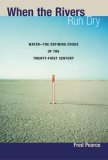Summary | Excerpt | Reviews | Beyond the Book | Readalikes | Genres & Themes | Author Bio

Critics' Opinion:
Readers' Opinion:
First Published:
Mar 2006, 320 pages
Paperback:
Mar 2007, 336 pages
 Book Reviewed by:
Book Reviewed by:
BookBrowse Review Team
Buy This Book
According to Mary Kelly, a leading environmentalist campaigning to save the river, pumping out this underground water could trigger the final and irreversible desiccation of the landscape. "Most of the recharge for the aquifer comes from seepage from the canals supplying the farms - which ultimately means it comes from the Rio Grande."
Downstream of El Paso, the river becomes a dribble of sewage effluent disappearing into remote scrub most of the way to Presidio. Hydrologically speaking, the Rio Grande pretty much ends here. Beyond Presidio, the river winds through dramatic canyons in the Big Bend National Park. But the flow is small and muddy. "We get about a sixth of the historical flow here," Dave Elkovitz of the park authority told me. A couple of weeks before my visit, the river dried up here for the first time in more than 50 years. Stagnant pools of water evaporated, leaving dry gravel beds and thousands of dead catfish. Starved of food, a troop of black bears headed back to Mexico. "We have treaties for the river," said Elkovitz. "But they allocate more water than actually exists. What good is that?"
The main treaty, signed in 1944, requires that one-third of the water flowing into the Rio Grande from six Mexican tributaries, much the largest of which is the Rio Conchos, is allocated to the US. The US can dry up the Rio Grande at El Paso as much as it wants, but, come hell or low water, the Mexicans have to deliver that quota. The treaty might have been fine 60 years ago when the rains could be relied upon, but what it means now is that northern Mexico is littered with irrigation areas living on borrowed time and water they owe to Texas.
Today, these districts are engaged in a major modernisation process to save water. Engineers are busy lining canals to prevent water seeping out of their porous bottoms. And they are installing perforated rubber piping to get water right to the plant roots rather than flooding fields. This $130m programme is being paid for mainly by the US government: the aim is to save 350m cubic metres of water a year. That volume close to the amount that Mexico should be sending down the Rio Conchos into the Rio Grande each year under the treaty terms.
"The Americans will get what we save," said one official. It sounds like a win:win situation: the Mexican farmers, I was told, would get greater water security, while the US gets its missing water. But there is a fallacy here: the modernisation will not actually make more water, and most of the savings are not real savings. The seepage will stop, but, says Kelly, that only means the aquifer will no longer be replenished.
As the canal water has failed in recent years, many farmers have come to rely on pumping underground water. But most of the underground water in the wells comes from seepage from the canals and fields. If the seepage is cut, the wells will dry up. According to Kelly, the modernisation plan will only hasten the aquifer's demise. The local irrigation engineers, and the people funding their work, seemed unconcerned by this prospect. But the tragedy is that to meet their immediate obligations to deliver water to Texan farmers, the Mexicans risk the loss of their vital underground water reserves.
Thanks to global trade, this is a scenario being played out the world over. Economists call the water involved in the growing and manufacture of products "virtual water". Every tonne of wheat arriving at a dockside, for example, carries with it in virtual form the 1,000 tonnes water needed to grow it. The world's virtual water trade is estimated to amount to be about 1,000 cubic kilometres a year, or 20 river Niles. Of that, two-thirds is in a huge range of crops from grains to vegetable oil, sugar to cotton; quarter is in meat and dairy products; and just a tenth in industrial products. This trade "moves water in volumes and over distances beyond the wildest imaginings of water engineers," says Tony Allan of the School of Oriental and African Studies in London, who invented the term "virtual water".
This is an edited extract from When Rivers Run Dry, by Fred Pearce, published by Beacon Press.





The Funeral Cryer by Wenyan Lu
Debut novelist Wenyan Lu brings us this witty yet profound story about one woman's midlife reawakening in contemporary rural China.
Your guide toexceptional books
BookBrowse seeks out and recommends the best in contemporary fiction and nonfiction—books that not only engage and entertain but also deepen our understanding of ourselves and the world around us.